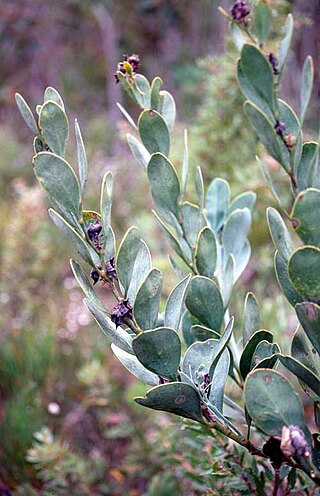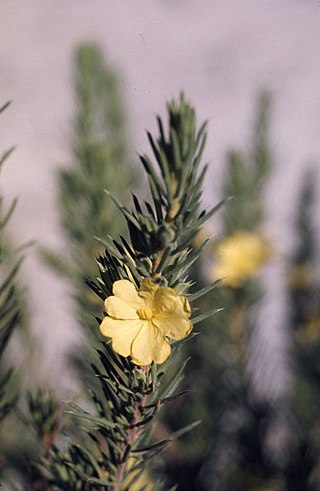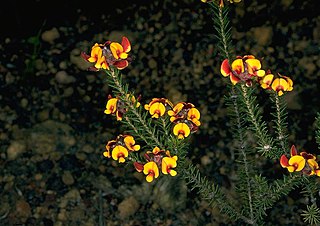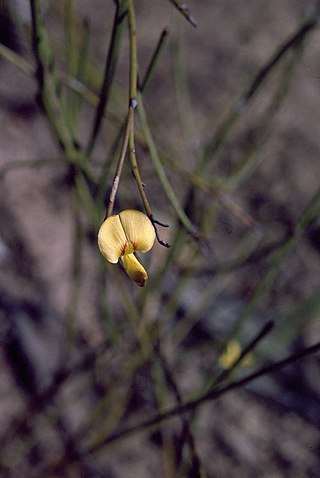Verticordia densiflora var. cespitosa is a flowering plant in the myrtle family, Myrtaceae and is endemic to the south-west of Western Australia. It is a shrub with small leaves and pink, or pink and white flowers. It is one of five varieties of the species Verticordia densiflora.

Thryptomene mucronulata is a species of flowering plant in the family Myrtaceae and is endemic to Western Australia. It is an erect shrub with upward-pointing, overlapping, egg-shaped leaves with the narrower end towards the base and pink flowers with five petals and ten stamens.

Daviesia obovata, commonly known as paddle-leaf daviesia, is a species of flowering plant in the family Fabaceae and is endemic to the south-west of Western Australia. It is an erect, slender shrub with scattered egg-shaped phyllodes with the narrower end towards the base, and yellow flowers with pale green markings.

Dillwynia uncinata, commonly known as silky parrot-pea, is a species of flowering plant in the family Fabaceae and is endemic to southern Australia. It is an erect, spreading shrub with cylindrical leaves and yellow flowers with a red centre.
Pultenaea adunca is a species of flowering plant in the family Fabaceae and is endemic to the south of Western Australia. It is an erect, spindly shrub with hairy, needle-shaped leaves and yellow and red flowers.
Pultenaea brachyphylla is a species of flowering plant in the family Fabaceae and is endemic to the south of Western Australia. It is an erect, spindly shrub with cylindrical, grooved leaves and yellow, orange and brown flowers.

Hibbertia mucronata is a species of flowering plant in the family Dilleniaceae and is endemic to the south of Western Australia. It is an erect shrub with hairy branches, crowded, thick, tapering linear leaves ending in a sharp point, and golden yellow flowers with five stamens fused at their bases, all on one side of two densely hairy carpels.
Bossiaea divaricata is a species of flowering plant in the family Fabaceae and is endemic to the southwest of Western Australia. It is a low, dense, openly-branched shrub with oblong to egg-shaped leaves and deep yellow and dark red flowers.
Pultenaea purpurea is a species of flowering plant in the family Fabaceae and is endemic to the south of Western Australia. It is a small prostrate shrub with cylindrical leaves and yellow-orange and red flowers.
Bossiaea peduncularis is a species of flowering plant in the family Fabaceae and is endemic to Western Australia. It is an erect, more or less leafless shrub with arching branches, cladodes ending with a point and deep yellow, red and greenish-yellow flowers.
Pultenaea spinulosa is a species of flowering plant in the family Fabaceae and is endemic to the south of Western Australia. It is a shrub with flat, hairy leaves, and uniformly yellow flowers.

Pultenaea verruculosa is a species of flowering plant in the family Fabaceae and is endemic to the south-west of Western Australia. It is an erect shrub with flat, hairy leaves, and yellow-orange and red, pea-like flowers.

Daviesia anceps is a species of flowering plant in the family Fabaceae and is endemic to the south of Western Australia. It is a dense, erect or low-lying shrub with its branchlets reduced to flattened cladodes, and yellow flowers with red markings.

Daviesia crenulata is a species of flowering plant in the family Fabaceae and is endemic to the south-west of Western Australia. It is a bushy shrub with broadly egg-shaped phyllodes with a sharply-pointed end and wavy edges, and uniformly yellow-orange and maroon flowers.

Daviesia lancifolia is a species of flowering plant in the family Fabaceae and is endemic to the south-west of Western Australia. It is a prostrate to erect, spreading shrub with egg-shaped, more or less round or linear phyllodes and yellow to orange and red flowers.

Lasiopetalum quinquenervium is a species of flowering plant in the family Malvaceae and is endemic to the south of Western Australia. It is an erect, spreading shrub with hairy stems and leaves, egg-shaped leaves and pink or white flowers.

Mirbelia subcordata is a species of flowering plant in the family Fabaceae and is endemic to the south-west of Western Australia. It is an erect, spreading shrub with egg-shaped to lance-shaped leaves and yellow or orange and red flowers.
Pimelea drummondii is a species of flowering plant in the family Thymelaeaceae and is endemic to near-coastal areas of southern Western Australia. It is an erect, slender shrub with narrowly elliptic or elliptic leaves arranged in opposite pairs, and white or cream-coloured flowers surrounded by 3 or 4 pairs of pale green to yellowish involucral bracts.

Thomasia brachystachys is a species of flowering plant in the family Malvaceae and is endemic to the Southwest Australia south-west of Western Australia. It is an open, erect shrub with egg-shaped to heart-shaped leaves and pink to mauve flowers.

Thomasia rhynchocarpa is a species of flowering plant in the family Malvaceae and is endemic to the Southwest Australia south-west of Western Australia. It is an erect, slender shrub with narrowly egg-shaped leaves with a heart-shaped base, and pink to purple flowers.











